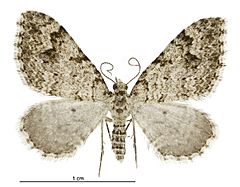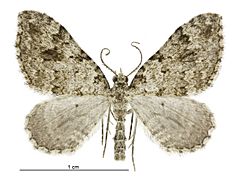Helastia cinerearia facts for kids
Quick facts for kids Helastia cinerearia |
|
|---|---|
 |
|
| Female | |
 |
|
| Male | |
| Scientific classification | |
| Kingdom: | |
| Phylum: | |
| Subphylum: | |
| Class: | |
| Order: | |
| Family: | |
| Genus: |
Helastia
|
| Species: |
H. cinerearia
|
| Binomial name | |
| Helastia cinerearia (Doubleday, 1843)
|
|
| Synonyms | |
|
|
The Helastia cinerearia is a small, fascinating moth found only in New Zealand. It belongs to a group of moths called Geometridae. These moths are often called "inchworms" or "loopers" in their caterpillar stage because of how they move.
This particular moth is special because it is endemic to New Zealand. This means you won't find it living naturally anywhere else in the world! It's a unique part of New Zealand's amazing wildlife.
Contents
Discovering the Helastia cinerearia Moth
The Helastia cinerearia moth was first described by a scientist named Edward Doubleday in 1843. This was a long time ago, showing how long scientists have been studying these creatures. Moths are Insects, just like butterflies, but they are usually active at night.
What Does This Moth Look Like?
Helastia cinerearia moths are typically small. They have wings that are often a mix of grey and brown colors. These colors help them blend in with their surroundings. This is a great way for them to hide from predators.
Like most moths, they have two pairs of wings. Their bodies are covered in tiny hairs or scales. These scales give the moth its color and patterns. You can see both male and female moths in the pictures in the infobox.
Where Does the Helastia Moth Live?
Since Helastia cinerearia is endemic to New Zealand, it lives in various habitats across the islands. Moths often prefer places with lots of plants. This is because their caterpillars need plants to eat.
They might be found in forests, shrublands, or even gardens. The specific type of plants available in an area helps determine if the moth can live there. Moths are an important part of the ecosystem.
The Life Cycle of a Moth
Moths, including the Helastia cinerearia, go through a complete metamorphosis. This means they change a lot during their lives. They start as an egg, then become a larva (caterpillar), then a pupa, and finally an adult moth.
From Egg to Adult Moth
The life cycle begins when a female moth lays tiny eggs. She usually places them on specific plants. These plants will be the food for the caterpillars when they hatch.
Once the eggs hatch, a small caterpillar emerges. This caterpillar's main job is to eat and grow. It will shed its skin several times as it gets bigger. This process is called molting.
After growing enough, the caterpillar changes into a pupa. For many moths, the pupa is inside a cocoon. The cocoon protects the pupa while it transforms. Inside the pupa, amazing changes happen. The caterpillar's body rearranges itself.
Finally, the adult moth emerges from the pupa. It will then fly, find a mate, and start the cycle all over again. The adult moth's main role is to reproduce.
What Do Moths Eat?
Adult Helastia cinerearia moths might feed on nectar from flowers. Nectar gives them energy to fly and find mates. Some moths do not eat at all as adults. They live off the energy stored from their caterpillar stage.
The caterpillars, however, are very hungry! They eat plant leaves. The type of plant they eat is very specific for each moth species. This is why female moths lay their eggs on certain plants.

